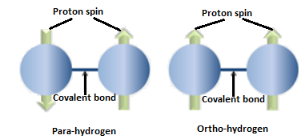
Ortho and para hydrogen differ:
(A) in the number of protons
(B) in the molecular mass
(C) in the nature of spins of protons
(D) in the nature of spins of electrons
Answer
474.9k+ views
1 likes
Hint: A hydrogen molecule is formed when two hydrogen atoms are combined together. A hydrogen atom consists of one proton and one electron.
Complete answer:A proton in an atom of hydrogen is composed of a charge of +1 as well as a spin. And we know that in a hydrogen molecule, we have two hydrogen atoms meaning we have two spins (one spin in each atom of hydrogen). The spin can be in any direction i.e. either clockwise or anti-clockwise. So in case of a hydrogen molecule, we have two possibilities i.e. the two spins can be both aligned (means both clockwise or both anti-clockwise) or in other cases, they can be opposed. Now, let us discuss the case of ortho and para hydrogen.
In Ortho hydrogen, the spins aligned in the same direction whereas in para hydrogen, the spins are aligned in opposite direction as shown in the figure below:

Hence, Ortho and para hydrogen differ in the nature of spins of protons.
Therefore, the correct answer is Option(C) .
Note:The amount of para and ortho hydrogen varies with the temperature. At 0°K, hydrogen is mainly composed of para-hydrogen which is considered to be more stable. At the temperature of air liquefaction, the ratio of ortho and para hydrogen is generally 1 : 1. On the other hand, at room temperature, the ratio of ortho and para hydrogen is 3 : 1.
Complete answer:A proton in an atom of hydrogen is composed of a charge of +1 as well as a spin. And we know that in a hydrogen molecule, we have two hydrogen atoms meaning we have two spins (one spin in each atom of hydrogen). The spin can be in any direction i.e. either clockwise or anti-clockwise. So in case of a hydrogen molecule, we have two possibilities i.e. the two spins can be both aligned (means both clockwise or both anti-clockwise) or in other cases, they can be opposed. Now, let us discuss the case of ortho and para hydrogen.
In Ortho hydrogen, the spins aligned in the same direction whereas in para hydrogen, the spins are aligned in opposite direction as shown in the figure below:

Hence, Ortho and para hydrogen differ in the nature of spins of protons.
Therefore, the correct answer is Option(C) .
Note:The amount of para and ortho hydrogen varies with the temperature. At 0°K, hydrogen is mainly composed of para-hydrogen which is considered to be more stable. At the temperature of air liquefaction, the ratio of ortho and para hydrogen is generally 1 : 1. On the other hand, at room temperature, the ratio of ortho and para hydrogen is 3 : 1.
Recently Updated Pages
Master Class 11 Economics: Engaging Questions & Answers for Success

Master Class 11 Business Studies: Engaging Questions & Answers for Success

Master Class 11 Accountancy: Engaging Questions & Answers for Success

Master Class 11 English: Engaging Questions & Answers for Success

Master Class 11 Computer Science: Engaging Questions & Answers for Success

Master Class 11 Maths: Engaging Questions & Answers for Success

Trending doubts
State and prove Bernoullis theorem class 11 physics CBSE

1 ton equals to A 100 kg B 1000 kg C 10 kg D 10000 class 11 physics CBSE

State the laws of reflection of light

One Metric ton is equal to kg A 10000 B 1000 C 100 class 11 physics CBSE

1 Quintal is equal to a 110 kg b 10 kg c 100kg d 1000 class 11 physics CBSE

Difference Between Prokaryotic Cells and Eukaryotic Cells




